Treating dentin hypersensitivity will cause one to make eating ice cream or taking coffee a painful experience. This is a guide to all you should know about tooth sensitivity and how to deal with the same. Whether it is the newest self-care products or established treatment methods, you will find viable methods of taking care of your enamel and preventing discomfort. We are also going to address such aspects as fluoride therapy, in-office solutions, and daily habits that will protect your teeth in the long run. It is time to forget about dental pain and get ready to have a healthier and stronger smile today.
WHAT IS DENTIN HYPERSENSITIVITY?
You already know what it means to experience dentin hypersensitivity, since you have, at some point, tasted an iced beverage and got an unexpected, pain-sharp sensation. It is not a great irritation but an indicator that the enamel that covers your teeth is becoming worn and this exposes tiny openings known as dentinal tubules. Once such tubules are exposed, hot, cold or even sweet sensations may be transmitted to the nerve of the tooth and may cause acute provoked pain. The data given by the American Dental Association states that approximately one out of eight adults in the United States is involved with tooth sensitivity, which is a rather surprising fact.
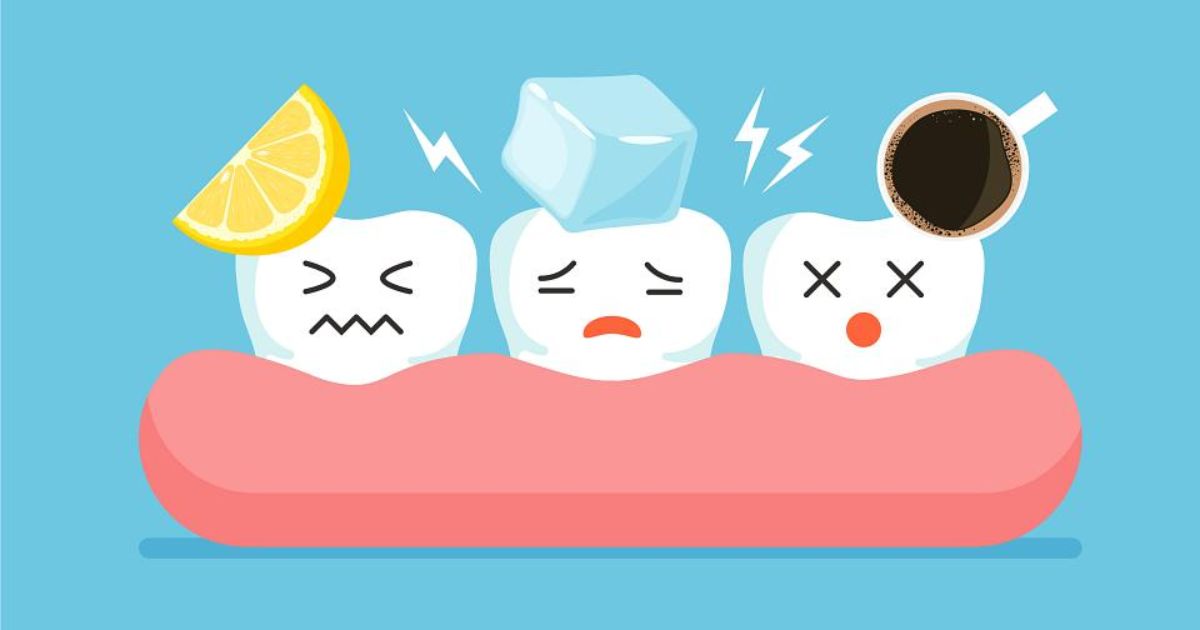
USUAL CAUSES OF SENSITIVITY OF THE TEETH
The sensitivity of the tooth does not occur instantly, in most cases, it builds up gradually, and you have room to do something before the pain is too much. When the protective covering of the enamel or gum tissue which covers the dentin is worn out, dentin hypersensitivity occurs. This reveals the dentinal tubules, which subject the dentin to sharp pains as a result of temperature change, pressure, or sugar. The first step in prevention is to know what causes this problem, as each cause has to be approached differently in the slightest.
Enamel Erosion
Enamel erosion is the major cause of tooth sensitivity. Soda and citrus juice, wine and other such acidic foods and beverages slowly erode the enamel exposing the dentin to exposure. This loss, in the course of time, leads to acute provoked pain with minimal triggers.
Gum Recession
The tooth roots are exposed by movement of the gums away, in old age, when brushing the teeth too hard or when the person has gum disease. This may cause pain since the surfaces of roots have no hard enamel as the crown.
Teeth Grinding and Clenching
Bruxism/ grinding of teeth wears away enamel and may lead to the development of cracks that are microscopic in nature. Such cracks enable the sensations to be closer to the nerve and lead to the increase of patient-reported outcomes of pain.
Cracked or Chipped Teeth
A single crack will allow entry of heat, cold or bacteria to aggravate the inner tooth structure. Cases of untreated cracks may be extremely sensitive, or even infected.
Aggressive Brushing Habits
The loss of enamel and loss of the gums may be caused by using a hard-bristled brush or scrubbing too hard. It is among the most avoidable causes of hypersensitivity of the dentine.
Whitening Treatments
Temporary increase in tooth sensitivity may take place with certain teeth whitening strips and gels as these products permit permeation of the dentin by whitening agents. This discomfort though temporary, may be alleviated using desensitising agents.
Dentin hypersensitivity has been found to be among the most prevalent dental complaints in the US with an estimated 45 million Americans having it annually (American Dental Association). By knowing these causes, you will be able to have a roadmap on how you can better manage and prevent future pain.
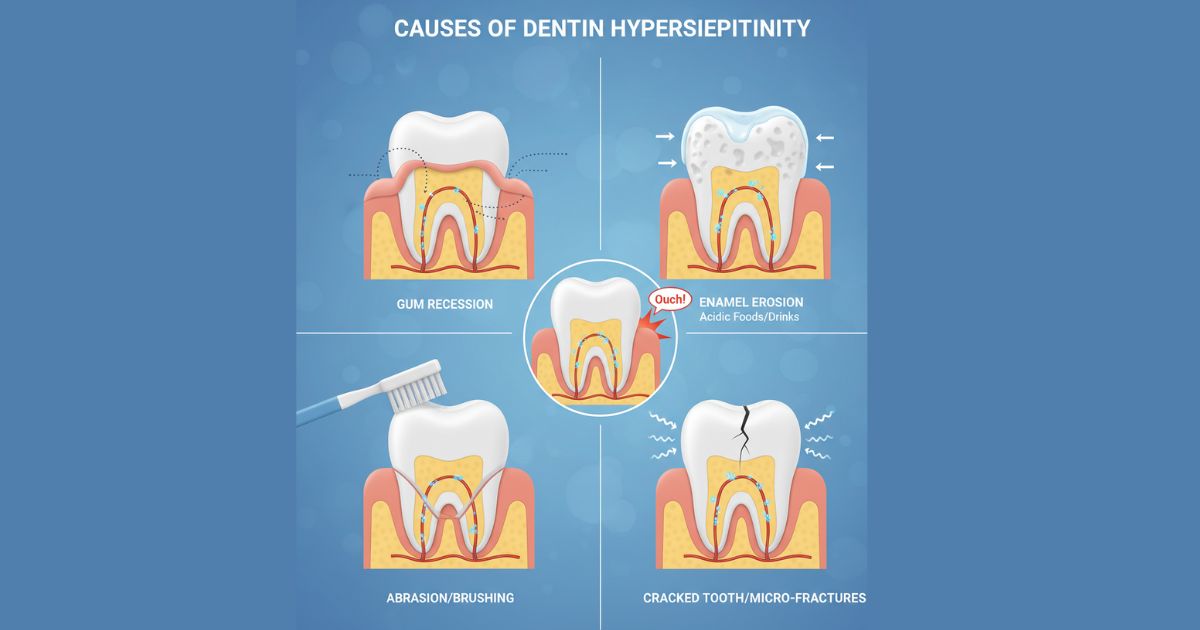
RED FLAGS TO BE WARY OF
Early detection of the initial signs of dentin hypersensitivity will prevent even larger problems in the dental area in the future. Sensitivity, however, can begin in a mild form and progress as time goes by thus it is easy to disregard it. Early detection ensures that you would be able to change your oral care program, change your diet, or even use desensitizing drugs before the pain advances to serious levels. Dentists stress the importance of management and prevention being effective as long as the issue is early addressed.
- Pain in the mouth or stomach which is sharp on intake of food or drink
- Pain when brushing or flossing
- Pain from cold air exposure
- Pain following the intake of sweet or sour food
- Whitening tingling
- Whitening and post-treatments
- Brief pain when biting down
Not all people experience the same symptoms of sensitivity, but the symptoms can be readily identified. Majority experience acute pain when brushing, flossing or inhaling chilled air. Victim may experience sharp pain when eating sweet desserts, sipping hot coffee or even when using home-use products such as whitening kits. The trick lies in observing the trends and intervene early as the untreated sensitivity may deteriorate with time causing even greater harm.
DIAGNOSIS OF TRIGGERS IN DENTIN HYPERSENSITIVITY
Uncovering the factors that leave you feeling out of place is an essential management/prevention task. Beginning a diary of the time of pain, what you were eating or drinking when the pain happened. Most patients learn that the major suspects are cold water, ice cream, or sour fruit such as oranges. Whitening strips, grinding teeth when stressed or even washing them too intensively can cause problems as well. Following these triggers, you and your dentist will be able to select more effective courses of treatment and prevent unnecessary discomfort.
AT-HOME SELF-CARE STRATEGIES
Dentin hypersensitivity takes control right in the home. Even minor modifications of your daily routine will help a lot to reduce pain and avoid additional harm to teeth. This is aimed at developing a strategy that would enable enamel reinforcement, reduction of triggers, and enhancement of long-term comfort. Together with professional advice, these in-home products and practices will be the basis of a successful treatment plan that will enhance your quality of life related to oral health.
ALTERNATE TO DESENSITIZING TOOTHPASTE
A potassium nitrate toothpaste or strontium chloride toothpaste will prevent the transmission of pain with time. In my case, the change in a toothpaste as a replacement with potassium nitrate usually made the most significant difference. These de-sensitizing agents act by soothing the tooth nerve and ensuring the root tubules are blocked causing relief to be felt in weeks.
Wireless Toothbrush- Soft Bristled
A gentle brush will ensure that there is no unnecessary loss of enamel and that also protects sensitive gums. Another way in which gum recession can be reduced is through gentle brushing.
Brush with Proper Technique
It should employ small circular movements at 45 degrees instead of rough back and forth scrubbing. This method decreases the enamel erosion and maintains the structure of the tooth.
Rinse with Lukewarm Water
Cold water may cause discomfort and this is particularly in cases where dentin is being exposed. The irritation is kept to minimum by the use of lukewarm water during brushing and rinsing. If you feel comfortable you can also go for oil pulling.
Always be True to your Practice
Imagine that this is the creation of a personalized oral hygiene program. Therapeutic dentifrice should be used regularly and consistently to ensure that the pain is relieved and no recurrence takes place.
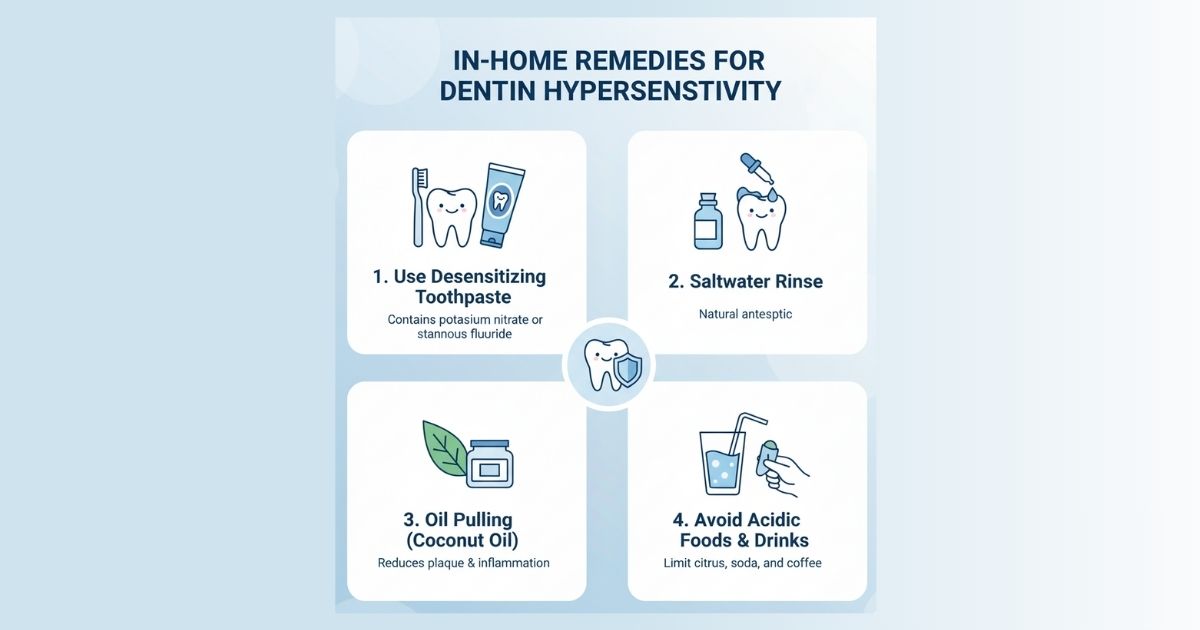
Doing something in the house can go a long way. The first thing to do is usually changing to a toothpaste containing potassium nitrate or strontium chloride since both of these desensitizing ingredients prevent the transmission of pain during the long run. A soft-bristled brush should be used, and jabbing should be avoided to scrub the enamel off. Irritation can also be prevented by rinsing with lukewarm water as opposed to using icy cold water. This is what you can consider creating your own oral hygiene routine – the one that is non-abrasive, consistent, and long-lasting.
THE BEST ORAL HYGIENE ON SENSITIVE TEETH
What you brush with is even more important than you are aware. Keep the brush at 45 degree angle and move it in small circles rather than making back and forth movements. Flossing is also important in the removal of plaque between the teeth as well as lessening the chances of gum recession. Enhancing enamel and preventing the loss of neutrophil root tubules as this prevents future sensitivity, this can be achieved through adding fluoride therapy or a fluoride mouth rinse. In many instances, dentists prescribe a dentifrice treatment as the component of the comprehensive therapy of permanent comfort.
FOOD TO EAT TO ELIMINATE TOOTH SENSITIVITY
Diet and beverage is very important in tooth protection. Reduce the amounts of soda, citrus juice and sports drinks because these products are acidic and can easily destroy enamel. In my opinion, one of the easiest methods to combat tooth sensitivity consists in lowering the consumption of soda. Without being able to resist, take a straw to limit the contact with teeth and rinse later with water. Consume calcium-enriched foods such as yogurt, cheese, and greens that will replace the minerals in enamel lost. Eating well is not only good to your body alone but also your health in terms of oral health.
| Food Category | Is good to be sensitive to? | Why It Helps |
| Dairy | Good | Enhances calcium and phosphates in the enamel |
| Leafy Greens | Good | Takes care of gums with minerals and vitamins. |
| Citrus | Not good | High acidity undermines enamel. |
| Soda | Not good | Sugar and acid erode the enamel. |
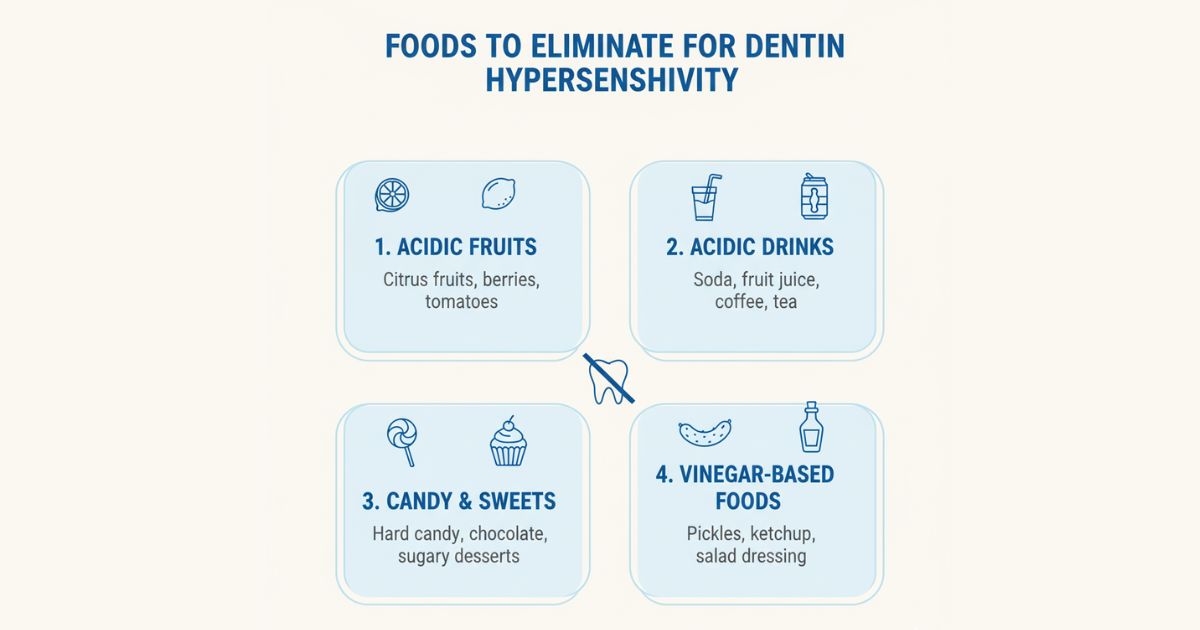
OVER THE COUNTER DESENSITIZATION EFFECTIVE PRODUCT
Dentin hypersensitivity may be controlled without necessarily visiting the dentist. Indeed, most individuals will feel relieved using selected over the counter oral care products. These are very common products that are easily accessible, easy to administer and have comforting research behind them of high clinical efficacy with regular use. With the appropriate self-care products and the right habits, you will be able to considerably decrease the level of discomfort, and you will be able to enhance the quality of life associated with oral health.
- Potassium Nitrate toothpaste: Potassium salts relax the nerve of the teeth and do not allow any pain message to reach the brain. It is among the best-prescription dentifrice in the therapy of sensitivity.
- Stannous Fluoride Toothpaste: Forms a protective coating on the exposed dentin and also helps in sealing of dentinal tubules making them less reactive to stimuli such as cold or sugar.
- Fluoride Gels: They will offer a high concentration of the fluoride therapy, which builds up the enamel and makes it less prone to the attack of acids.
- Mouth washes for Sensitivity: Washes with fluoride are best used at night, they help to protect the teeth as sleeping goes on and also cover those parts which may be missed during brushing.
- Desensitizing Strips or Paint-On Gels: These are specific items that apply active contents in sensitive regions to achieve a faster effect.
LONG-TERM RELIEF LIFESTYLE- CHANGES
More than toothpaste is required to find permanent solution to dentin hypersensitivity. Habits you practice on a daily basis could preserve or destroy your teeth and even minor changes could make the biggest difference. Emphasis on stress and nutritional guidelines, as well as oral hygiene and care practices, creates an effective background of future comfort. Personally, I wear a nightguard and this has changed everything in my opinion because I grind my teeth. The studies support these changes with the measurement of the improvement of patient-reported outcomes and dental sensitivity reduction in the long run.
- Reduce daily stress
- Wear a nightguard
- Quit smoking
- Limit sugary snacks
- Have periodical dental examinations
- Do not take acidic beverages frequently
- Stay hydrated with water
- Have soft brushing habits
WHEN TO SEEK PROFESSIONAL DENTAL TREATMENT
Sometimes taking care of yourself is not enough. Once pain does not disappear after the weeks of self-care products usage, it is high time to visit a dentist. They can use fluoride varnish or prescribe in-office such treatment as bonding agents or sealants to ensure the coverage of exposed locations. It is aimed at preventing the renewal of pain and preserving tooth material. Dentists are also able to examine more severe issues that may be causing the discomfort that could include cracks or deep holes.
IN-CLINIC TREATMENTS OF SEVERE SENSITIVITY
Dentin hypersensitivity can be too painful to treat without a professional intervention, which can produce strong outcomes. Advanced methods and in-office treatments have been available to dentists and will prevent pain where it originated and harden weak parts of your teeth. These processes concern protecting over the long term and they are usually supplemented by fluoride therapy or other treatment methods to avoid future flare-up.
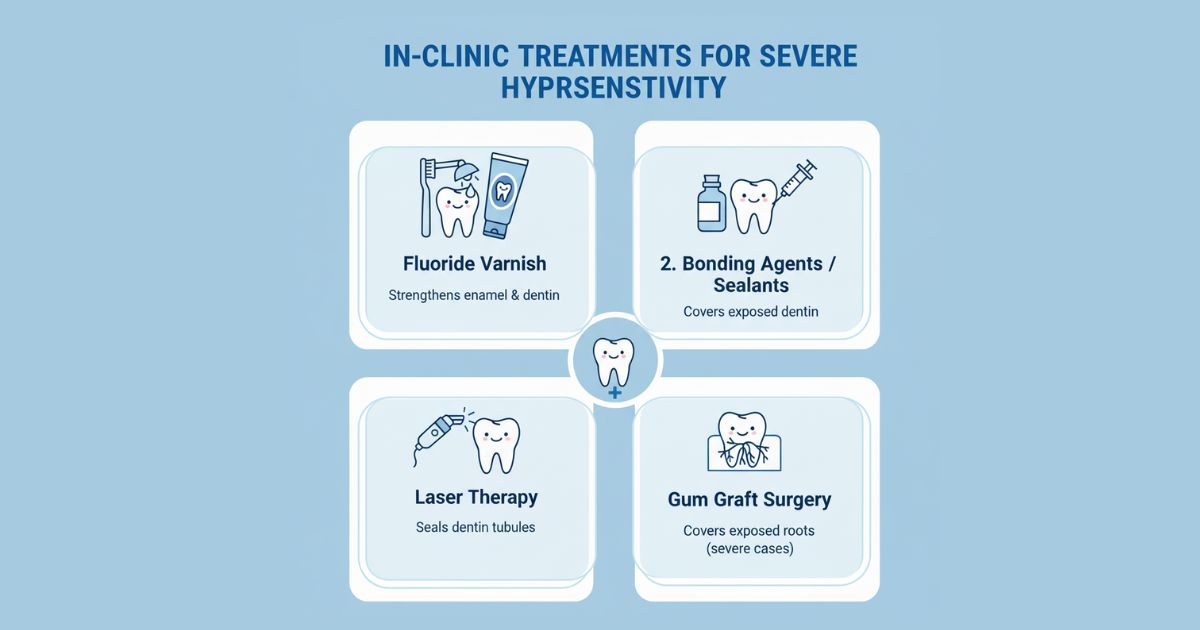
- Strength of fluoride therapy that is of professional level
- Gum grafting procedures
- Dental tubules Laser treatment
- Use of bonding agents
- Use of dental sealants
- Gels of desensitizing strength of prescription
FOLLOW-UP AND MAINTENANCE TO SUSTAIN LONG-TERM RESULTS
Regular check-up helps in my case to avoid problems before they begin considerably easier. The alleviation of dentin hypersensitivity is not a single intervention, but a long-term procedure. Ok, check-ups with your dentist no less than two times a year so that your dentist could see how you are doing and change your care plan. Continue taking therapeutic dentifrice, and do not relapse into bad habits. An ounce of prevention is a pound of cure, and this is very true as far as tooth health is concerned. Continued care means that you will not be in pain and that you have a strong smile.
FAQs
Q1: What is dentin hypersensitivity and why is it painful?
Dentin hypersensitivity occurs when dentin is exposed with stimuli such as heat or cold causing pain by conducting the stimuli to tooth nerves.
Q2: What can I do to prevent tooth sensitivity in the house?
Apply potassium nitrate toothpaste, soft brush and avoid acidic food. Pain reduction is achieved as a result of consistency with self-care products.
Q3: What are the foods that I would not want when I have sensitive teeth?
Avoid soda, citrus and sweetened food. These destroy enamel and make it sensitive. wash with water following acidic beverages.
Q4: Are desensitizing toothpastes actually effective?
Yes, therapeutic dentifrice containing potassium nitrate or strontium compounds block the transmission of pain and support the strengthening of the enamel, which increases the comfort 244 weeks.
Q5: What is the time that I need to visit a dentist with tooth sensitivity?
In case of persistence of pain weeks after at home care or aggravation, then request in-office therapy like fluoride varnish, bonding or sealants.

 Medically reviewed by
Medically reviewed by